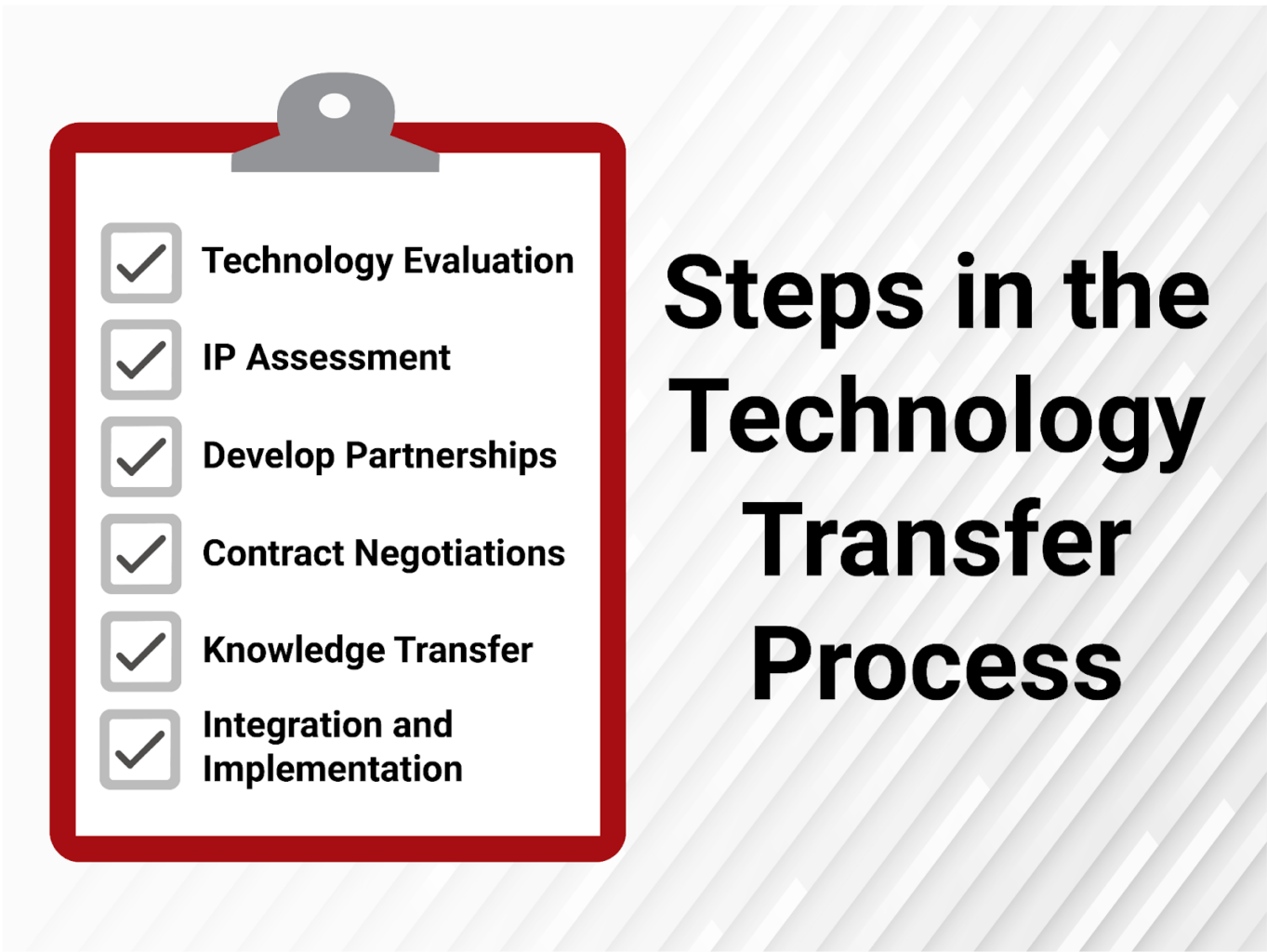Technology Transfer: An Engine for Innovation
Technology transfer is the process of transferring knowledge, intellectual property, or technical capabilities from one organization to another. For ktMINE users, effective technology transfer is crucial for bringing their innovations to the market. This blog highlights technology transfer, its benefits, challenges, and keys to success.
Types of Technology Transfer
Intracompany Technology Transfer
Intracompany technology transfer involves sharing knowledge, expertise, and capabilities between different areas within the same organization. Large companies often have dedicated teams to facilitate knowledge transfer across the business. Effective internal transfer allows organizations to maximize the value of their R&D investments.
- Knowledge Sharing: Employees share their expertise, best practices, and lessons learned with colleagues in other departments or locations.
- Skill Development: Providing training programs, workshops, or mentorship opportunities to employees to enhance their skills and capabilities.
- Cross-functional Collaboration: Encouraging collaboration between teams with diverse skill sets to tackle complex problems or develop innovative solutions.
Intercompany Technology Transfer
Intercompany technology transfer refers to the transfer of technology assets and IP between two or more companies. This helps companies gain quick access to innovations that accelerate their product development. Forms of intercompany transfer include licensing agreements, R&D partnerships, and university-industry collaborations.
- Licensing Agreements: Companies allow the use of their technology or IP to other organizations for commercial use in exchange for royalties or licensing fees.
- Joint Ventures: Collaborative partnerships between companies to jointly develop or commercialize new technologies, products, or services.
- Research Collaborations: Cooperative research initiatives between companies, academic institutions, or research organizations to address common challenges or pursue shared objectives.
- Supply Chain Integration: Integration of technology or processes between different companies within a supply chain to improve efficiency, quality, or sustainability.
University-led Technology Transfer
University-led technology transfer involves the movement of knowledge, technologies, and innovations developed within academic institutions to external organizations. This process enables universities to contribute to economic growth and industry advancement by turning research findings into marketable products and services. Universities typically have dedicated technology transfer offices to manage these activities.
- Intellectual Property Management: Universities often patent inventions and protect other forms of IP developed by their researchers. This ensures that the innovations can be legally transferred to and utilized by external partners.
- Licensing Agreements: Universities license their IP to companies that can commercialize the technology. These agreements can involve upfront fees, milestone payments, and royalties based on product sales.
- Startup Creation: Universities support the creation of spin-off companies to commercialize university research. These startups often receive access to university resources, mentorship, and funding opportunities.
- Industry Partnerships: Universities collaborate with industry partners on research and development projects. These partnerships can range from short-term consultancies to long-term strategic alliances, fostering innovation and practical applications of academic research.
- Incubation and Acceleration Programs: Universities often host incubators and accelerators to support early-stage companies and entrepreneurs. These programs provide resources such as funding, mentorship, office space, and networking opportunities.
- Knowledge Exchange and Consultancy: Academics provide expertise and consultancy services to the industry, helping to solve specific problems or improve processes through the application of their research findings.
Government-led Technology Transfer
Governments aim to promote economic growth by investing in R&D and facilitating technology transfer. Government labs and academic institutions receive R&D funding with the mandate to transfer inventions to industry for commercialization. Policies like the Bayh-Dole Act have enabled many government-funded technologies to reach the market.
- Funding Programs: Providing grants, loans, or incentives to support technology transfer activities, research collaborations, or the commercialization of innovative technologies.
- Regulatory Support: Establishing policies, regulations, or frameworks that promote technology transfer, intellectual property rights, and commercialization activities.
- Technology Transfer Offices: Establishing technology transfer offices or agencies to facilitate the licensing of government-owned technologies, patents, or inventions to the private sector.
- Public-Private Partnerships: Collaborative initiatives between government agencies, industry partners, and academic institutions to leverage resources, expertise, and funding for technology transfer projects.
Benefits of Technology Transfer
Technology transfer accelerates innovation by promoting the rapid integration of new ideas, knowledge, and technologies into organizational products, processes, and services. By leveraging external expertise and resources, organizations can quickly adopt these innovations, enabling a dynamic environment of technological advancements. This process allows organizations to maintain a leading edge in their industries, ensuring they remain competitive and relevant in a rapidly evolving market landscape.
Additionally, technology transfer allows organizations to access external technologies, expertise, and best practices, enhancing their capabilities and improving efficiency. This external adaptation often results in significant performance improvements and enables organizations to meet market demands better. Technology transfer can also substantially reduce R&D costs by allowing organizations to leverage existing solutions rather than developing new technologies. This cost-saving measure frees up resources for other critical development areas. Organizations can increase competitiveness, attract additional customers, and secure a stronger market position by continuously updating and enhancing product offerings. Moreover, technology transfer facilitates the commercialization of innovative ideas and research findings, transforming scientific discoveries into marketable products and services that generate revenue and drive economic growth.
Challenges in Technology Transfer
Technology transfer presents several significant challenges, with protecting IP rights being a primary concern. Organizations must develop strategies for patenting, licensing, and enforcing IP rights to safeguard their innovations. Effective IP protection is crucial to prevent unauthorized use or infringement by competitors, ensuring that the rightful owners fully realize the benefits of technological advancements.
Another major challenge is overcoming cultural differences between collaborating organizations. Technology transfer often involves entities with varying cultures, work practices, and communication styles. Bridging these differences is essential for fostering effective collaboration and knowledge sharing. This requires strong communication skills and mutual understanding to ensure all parties are aligned and working towards the same goals.
Building mutual trust among technology transfer partners is another key challenge. Trust is fundamental for open communication, sharing proprietary information, and mitigating risks. Establishing clear agreements, transparent processes, and mutual respect can help build this trust and facilitate smoother transactions.
Finally, managing knowledge gaps is crucial for the successful implementation and adoption of transferred technologies. This involves transferring knowledge, expertise, and know-how between individuals or organizations. Addressing skill or capability mismatches and providing adequate training and support are essential to ensure effective knowledge transfer and successful technology integration.
Steps in the Technology Transfer Process
- Technology Evaluation: Assess the technical and market potential of the technology, including product-market fit, commercial viability, and strategic alignment.
- IP Assessment: Conduct due diligence on the ownership, scope, and strength of IP protections around the technology. Ensure that proper IP protections are in place.
- Develop Partnerships: Identify potential partners and build relationships based on aligned objectives, shared vision, and mutual trust.
- Contract Negotiation: Develop licensing contracts that protect IP and align the incentives of all parties involved.
- Knowledge Transfer: Facilitate effective absorption of technical knowledge through documentation, training workshops, and ongoing support.
- Integration and Implementation: Adapt processes and systems within the receiving organizations to fully leverage the absorbed technologies.
Emerging Trends and Models
- Digital Platforms for Tech Transfer: Platforms that facilitate the connection between innovators and organizations seeking new technologies.
- Tech Transfer Intermediaries: Organizations that act as brokers or facilitators in the technology transfer process.
- AI for Tech Evaluation and IP Management: Utilizing artificial intelligence to assess the potential and manage the IP of new technologies.
- Global Technology Partnerships: Cross-border collaborations that leverage global expertise and markets for technology transfer.
- Developing and Supporting Start-Ups: Fostering new business start-ups out of university-led developments versus traditional licensing.
Technology transfer is a crucial process that drives innovation, enhances competitiveness, and facilitates the commercialization of new technologies. While it presents several challenges, strategic planning, robust IP protection, effective collaboration, and strong partnerships can overcome these hurdles. As new trends and models emerge, the future of technology transfer looks promising, with the potential for significant economic and societal impacts.






